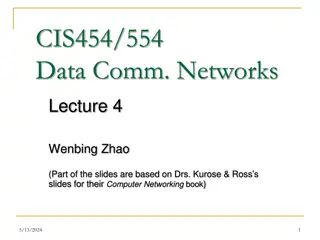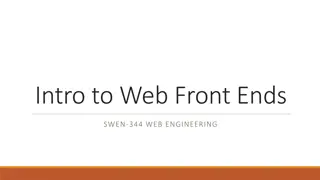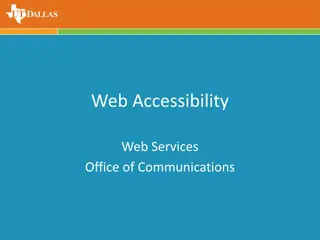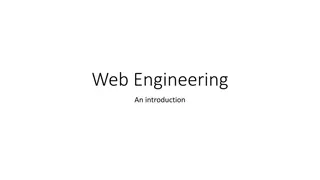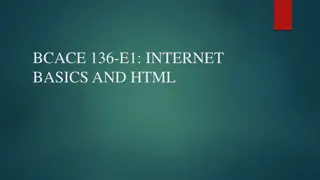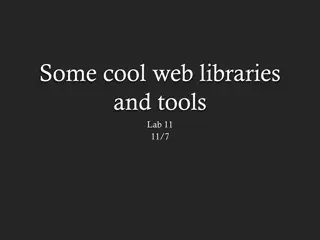Understanding Web Technology: Tools, Techniques, and Evolution
Introduction to Web Technology covering the definition, history of the World Wide Web, types of websites - static and dynamic, web pages, basics of HTML, and more. Explore the concepts that underpin communication between devices over the Internet and the evolution of websites.
Download Presentation

Please find below an Image/Link to download the presentation.
The content on the website is provided AS IS for your information and personal use only. It may not be sold, licensed, or shared on other websites without obtaining consent from the author. Download presentation by click this link. If you encounter any issues during the download, it is possible that the publisher has removed the file from their server.
E N D
Presentation Transcript
Web Technology Mr. G. P. Shinde
Introduction to Web Technology Web Technology refers to the various tools and techniques that are utilized in the process of communication between different types of devices over the Internet . History of WWW www is world wide web and it is an advanced finding information system. by Sir Tim Berners-Lee. He is best known as the inventor of the World Wide Web, he was a researcher scientist at CERN (The European Council for Nuclear Research) laboratory in Geneva, Switzerland. Web1.0 1989 - it is just the readable site with raw data of the World Wide Web Web2.0 2004- web1.0 presents to the user accessing possibility to upload and download from the webpage Web3.0 2014 to till- Web 3.0 will be a complete reinvention of the web.
Website A website is a collection of interlinked web pages with a common domain name. The website can be made by any individual, group, or company. Ex. google.com, youtube.com. All the websites that are accessible publicly come under the World Wide Web. Most of the websites are dedicated to a particular topic or purpose, for example, education, news, commerce, entertainment, or Social networking. The websites start with a home page, which is followed by some navigation page that is linked by the Hyperlinking between the web pages.
Types of Website There are two fundamental types of websites 1) Static website 2) Dynamic website Static website The combination of web pages that are stored on a server in the same format that is sent to a client's web browser is a Static website. The static websites are initially coded in the HTML and CSS Dynamic website A dynamic website is a collection of webpages that change or customizes itself automatically and frequently. These types of websites are usually created using server-side programming languages, such as PHP.
Web Pages A web page is a single hypertext document available on World Wide Web (WWW). A webpage is a document written in HTML and can be viewed on any web browser such as Mozilla, Firefox, Chrome, etc. It is also referred to as "Page. Each webpage is linked with a unique URL. A webpage may contain text, links for other pages, graphics, videos, etc. The main element of the webpage is a text file composed of HTML.
HTML Basics Structure of HTML HTML elements are hierarchical meaning we can create elements inside of an element. The html structure contains following tags <!DOCTYPE> -This tag defines the document type and HTML version. <html> - This tag encloses the complete HTML document <head> -This tag represents the document's header which can keep other HTML tags like <title> <title> -The <title> tag is used inside the <head> tag to mention the document title. <body> -This tag represents the document's body which keeps other HTML tags.
What is Tag HTML tags are like keywords which defines that how web browser will format and display the content. HTML tags contain three main parts opening tag Ex. <p> Content - The information which displayed on web browser closing tag -</p> All HTML tags must enclosed within < > these brackets. If you have used an open tag <ex>, then you must use a close tag </ex>. Ex. <tag> content </tag>
Basic Tags Center Tag Ex.<center>This is sample Text</center> Preserve Formatting Tag <pre>P P P P P </pre> Bold Tag Ex. .<center><b>This</b> is sample Text</center> Italic Tag Ex. .<center><b>This</b> is <i>sample</i> Text</center> Underline Tag Ex. .<center><b>This</b> is sample <u>Text</u></center>
Attributes & Value HTML attributes are special words which provide additional information about the elements or attributes are the modifier of the HTML element. Each element or tag can have attributes, which defines the behaviour of that element. Attributes should always be applied with start tag. The Attribute should always be applied with its name and value pair. The Attributes name and values are not case sensitive. You can add multiple attributes in one HTML element, but need to give space between two attributes. Syntax. <body bgcolor= pink ></body>


